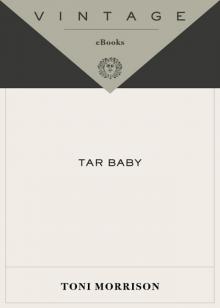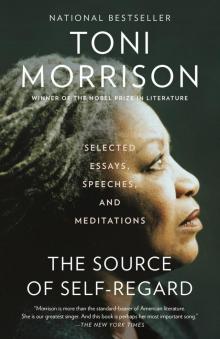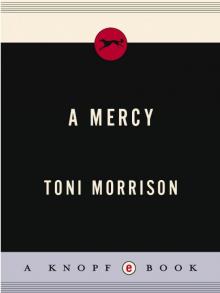Sula Read online
Contents
TITLE PAGE
DEDICATION
EPIGRAPH
FOREWORD
PART ONE
1919
1920
1921
1922
1923
1927
PART TWO
1937
1939
1940
1941
1965
ABOUT THE AUTHOR
ALSO BY TONI MORRISON
ACCLAIM FOR TONI MORRISON’S SULA
COPYRIGHT
It is sheer good fortune to miss
somebody long before they leave you.
This book is for Ford and Slade, whom
I miss although they have not left me.
“Nobody knew my rose of the world
but me…. I had too much glory.
They don’t want glory like that
in nobody’s heart.”
—The Rose Tattoo
FOREWORD
In the fifties, when I was a student, the embarrassment of being called a politically minded writer was so acute, the fear of critical derision for channeling one’s creativity toward the state of social affairs so profound, it made me wonder: Why the panic? The flight from any accusation of revealing an awareness of the political world in one’s fiction turned my attention to the source of the panic and the means by which writers sought to ease it. What could be so bad about being socially astute, politically aware in literature? Conventional wisdom agrees that political fiction is not art; that such work is less likely to have aesthetic value because politics—all politics—is agenda and therefore its presence taints aesthetic production.
That wisdom, which seems to have been unavailable to Chaucer, or Dante, or Catullus, or Sophocles, or Shakespeare, or Dickens, is still with us, and, in 1969 it placed an inordinate burden on African American writers. Whether they were wholly uninterested in politics of any sort, or whether they were politically inclined, aware, or aggressive, the fact of their race or the race of their characters doomed them to a “political-only” analysis of their worth. If Phillis Wheatley wrote “The sky is blue,” the critical question was what could blue sky mean to a black slave woman? If Jean Toomer wrote “The iron is hot,” the question was how accurately or poorly he expressed chains of servitude. This burden rested not only on the critics, but also on the reader. How does a reader of any race situate herself or himself in order to approach the world of a black writer? Won’t there always be apprehension about what may be revealed, exposed about the reader?
In 1970, when I began writing Sula, I had already had the depressing experience of reading commentary on my first novel, The Bluest Eye, by both black and white reviewers that—with two exceptions—had little merit since the evaluation ignored precisely the “aesthetics only” criteria it championed. If the novel was good, it was because it was faithful to a certain kind of politics; if it was bad, it was because it was faithless to them. The judgment was based on whether “Black people are—or are not—like this.” This time out, I returned the compliment and ignored the shallowness of such views and, again, rooted the narrative in a landscape already tainted by the fact that it existed. Only a few people would be interested, I thought, in any wider approach—fewer than the tiny percentage of the fifteen hundred who had bought the first book. But the act of writing was too personally important for me to abandon it just because the prospects of my being taken seriously were bleak. It may be difficult now to imagine how it felt to be seen as a problem to be solved rather than a writer to be read. James Baldwin, Ralph Ellison, Richard Wright, Zora Neale Hurston—all had been called upon to write an essay addressing the “problem” of being a “Negro” writer. In that no-win situation—inauthentic, even irresponsible, to those looking for a politically representative canvas; marginalized by those assessing value by how “moral” the characters were—my only option was fidelity to my own sensibility. Further exploration of my own interests, questions, challenges. And since my sensibility was highly political and passionately aesthetic, it would unapologetically inform the work I did. I refused to explain, or even acknowledge, the “problem” as anything other than an artistic one. Other questions mattered more. What is friendship between women when unmediated by men? What choices are available to black women outside their own society’s approval? What are the risks of individualism in a determinedly individualistic, yet racially uniform and socially static, community?
Female freedom always means sexual freedom, even when—especially when—it is seen through the prism of economic freedom. The sexual freedom of Hannah Peach was my entrance into the story, constructed from shreds of memory about the way local women regarded a certain kind of female—envy coupled with amused approbation. Against her fairly modest claims to personal liberty are placed conventional and anarchic ones: Eva’s physical sacrifice for economic freedom; Nel’s accommodation to the protection marriage promises; Sula’s resistance to either sacrifice or accommodation. Hannah’s claims are acceptable in her neighborhood because they are nonfinancial and nonthreatening; she does not disturb or deplete family resources. Because her dependence is on another woman, Eva, who has both money and authority, she is not competitive. But Sula, although she does nothing so horrendous as what Eva does, is seen by the townspeople as not just competitive, but devouring, evil. Nel, with the most minimal demands, is seen as the muted standard.
Hannah, Nel, Eva, Sula were points of a cross—each one a choice for characters bound by gender and race. The nexus of that cross would be a merging of responsibility and liberty difficult to reach, a battle among women who are understood to be least able to win it. Wrapped around the arms of that cross were wires of other kinds of battles—the veteran, the orphans, the husband, the laborers, confined to a village by the same forces that mandated the struggle. And the only possible triumph was that of the imagination.
The job, of course, was summoning those perceptions in language that could express them. Sula stretched my attempts to manipulate language, to work credibly and, perhaps, elegantly with a discredited vocabulary. To use folk language, vernacular in a manner neither exotic nor comic, neither minstrelized nor microscopically analyzed. I wanted to redirect, reinvent the political, cultural, and artistic judgments saved for African American writers.
I was living in Queens while I wrote Sula, commuting to Manhattan to an office job, leaving my children to child-minders and the public school in the fall and winter, to my parents in the summer, and was so strapped for money that the condition moved from debilitating stress to hilarity. Every rent payment was an event; every shopping trip a triumph of caution over the reckless purchase of a staple. The best news was that this was the condition of every other single/separated female parent I knew. The things we traded! Time, food, money, clothes, laughter, memory—and daring. Daring especially, because in the late sixties, with so many dead, detained, or silenced, there could be no turning back simply because there was no “back” back there. Cut adrift, so to speak, we found it possible to think up things, try things, explore. Use what was known and tried and investigate what was not. Write a play, form a theater company, design clothes, write fiction unencumbered by other people’s expectations. Nobody was minding us, so we minded ourselves. In that atmosphere of “What would you be doing or thinking if there was no gaze or hand to stop you?” I began to think about just what that kind of license would have been like for us black women forty years earlier. We were being encouraged to think of ourselves as our own salvation, to be our own best friends. What could that mean in 1969 that it had not meant in the 1920s? The image of the woman who was both envied and cautioned against came to mind.
Elsewhere (in an essay “Unspeakable Things Unspoken”), I have detailed my thoughts about developing the st
ructure of Sula. “Originally, Sula opened with ‘Except for World War II, nothing interfered with National Suicide Day.’ With some encouragement I recognized that sentence as a false beginning.” Falseness, in this case, meant abrupt. There was no lobby, as it were, where the reader could be situated before being introduced to the goings-on of the characters. As I wrote in that essay, “The threshold between the reader and the black-topic text need not be the safe, welcoming lobby I persuaded myself [Sula] needed at that time. My preference was the demolition of the lobby altogether. [Of all of my books], only Sula has this ‘entrance.’ The others refuse the ‘presentation,’ refuse the seductive safe harbor; the line of demarcation between…them and us. Refuse, in effect, to cater to the diminished expectations of the reader, or his or her alarm heightened by the emotional luggage one carries into the black-topic text…. [Although] the bulk of the opening I finally wrote is about the community, a view of it…the view is not from within…but from the point of view of a stranger—the ‘valley man’ who might happen to be there and to and for whom all this is mightily strange, even exotic….[In] my new first sentence I am introducing an outside-the-circle reader into the circle. I am translating the anonymous into the specific, a ‘place’ into a ‘neighborhood’ and letting a stranger in, through whose eyes it can be viewed.” This deference, paid to the “white” gaze, was the one time I addressed the “problem.”
Had I begun with Shadrack, as originally planned, I would have ignored the gentle welcome and put the reader into immediate confrontation with his wounded mind. It would have called greater attention to the traumatic displacement this most wasteful capitalist war had on black people, and thrown into relief their desperate and desperately creative strategies of survival. In the revised opening I tried to represent discriminatory, prosecutorial racial oppression as well as the community’s efforts to remain stable and healthy: the neighborhood has been almost completely swept away by commercial interests (a golf course), but the remains of what sustained it (music, dancing, craft, religion, irony, wit) are what the “valley man,” the stranger, sees—or could have seen. It is a more inviting embrace than Shadrack’s organized public madness—it helps to unify the neighborhood until Sula’s anarchy challenges it.
Outlaw women are fascinating—not always for their behavior, but because historically women are seen as naturally disruptive and their status is an illegal one from birth if it is not under the rule of men. In much literature a woman’s escape from male rule led to regret, misery, if not complete disaster. In Sula I wanted to explore the consequences of what that escape might be, on not only a conventional black society, but on female friendship. In 1969, in Queens, snatching liberty seemed compelling. Some of us thrived; some of us died. All of us had a taste.
In that place, where they tore the nightshade and blackberry patches from their roots to make room for the Medallion City Golf Course, there was once a neighborhood. It stood in the hills above the valley town of Medallion and spread all the way to the river. It is called the suburbs now, but when black people lived there it was called the Bottom. One road, shaded by beeches, oaks, maples and chestnuts, connected it to the valley. The beeches are gone now, and so are the pear trees where children sat and yelled down through the blossoms to passersby. Generous funds have been allotted to level the stripped and faded buildings that clutter the road from Medallion up to the golf course. They are going to raze the Time and a Half Pool Hall, where feet in long tan shoes once pointed down from chair rungs. A steel ball will knock to dust Irene’s Palace of Cosmetology, where women used to lean their heads back on sink trays and doze while Irene lathered Nu Nile into their hair. Men in khaki work clothes will pry loose the slats of Reba’s Grill, where the owner cooked in her hat because she couldn’t remember the ingredients without it.
There will be nothing left of the Bottom (the footbridge that crossed the river is already gone), but perhaps it is just as well, since it wasn’t a town anyway: just a neighborhood where on quiet days people in valley houses could hear singing sometimes, banjos sometimes, and, if a valley man happened to have business up in those hills—collecting rent or insurance payments—he might see a dark woman in a flowered dress doing a bit of cakewalk, a bit of black bottom, a bit of “messing around” to the lively notes of a mouth organ. Her bare feet would raise the saffron dust that floated down on the coveralls and bunion-split shoes of the man breathing music in and out of his harmonica. The black people watching her would laugh and rub their knees, and it would be easy for the valley man to hear the laughter and not notice the adult pain that rested somewhere under the eyelids, somewhere under their head rags and soft felt hats, somewhere in the palm of the hand, somewhere behind the frayed lapels, somewhere in the sinew’s curve. He’d have to stand in the back of Greater Saint Matthew’s and let the tenor’s voice dress him in silk, or touch the hands of the spoon carvers (who had not worked in eight years) and let the fingers that danced on wood kiss his skin. Otherwise the pain would escape him even though the laughter was part of the pain.
A shucking, knee-slapping, wet-eyed laughter that could even describe and explain how they came to be where they were.
A joke. A nigger joke. That was the way it got started. Not the town, of course, but that part of town where the Negroes lived, the part they called the Bottom in spite of the fact that it was up in the hills. Just a nigger joke. The kind white folks tell when the mill closes down and they’re looking for a little comfort somewhere. The kind colored folks tell on themselves when the rain doesn’t come, or comes for weeks, and they’re looking for a little comfort somehow.
A good white farmer promised freedom and a piece of bottom land to his slave if he would perform some very difficult chores. When the slave completed the work, he asked the farmer to keep his end of the bargain. Freedom was easy—the farmer had no objection to that. But he didn’t want to give up any land. So he told the slave that he was very sorry that he had to give him valley land. He had hoped to give him a piece of the Bottom. The slave blinked and said he thought valley land was bottom land. The master said, “Oh, no! See those hills? That’s bottom land, rich and fertile.”
“But it’s high up in the hills,” said the slave.
“High up from us,” said the master, “but when God looks down, it’s the bottom. That’s why we call it so. It’s the bottom of heaven—best land there is.”
So the slave pressed his master to try to get him some. He preferred it to the valley. And it was done. The nigger got the hilly land, where planting was backbreaking, where the soil slid down and washed away the seeds, and where the wind lingered all through the winter.
Which accounted for the fact that white people lived on the rich valley floor in that little river town in Ohio, and the blacks populated the hills above it, taking small consolation in the fact that every day they could literally look down on the white folks.
Still, it was lovely up in the Bottom. After the town grew and the farm land turned into a village and the village into a town and the streets of Medallion were hot and dusty with progress, those heavy trees that sheltered the shacks up in the Bottom were wonderful to see. And the hunters who went there sometimes wondered in private if maybe the white farmer was right after all. Maybe it was the bottom of heaven.
The black people would have disagreed, but they had no time to think about it. They were mightily preoccupied with earthly things—and each other, wondering even as early as 1920 what Shadrack was all about, what that little girl Sula who grew into a woman in their town was all about, and what they themselves were all about, tucked up there in the Bottom.
1919
Except for World War II, nothing ever interfered with the celebration of National Suicide Day. It had taken place every January third since 1920, although Shadrack, its founder, was for many years the only celebrant. Blasted and permanently astonished by the events of 1917, he had returned to Medallion handsome but ravaged, and even the most fastidious people in the town sometimes cau
ght themselves dreaming of what he must have been like a few years back before he went off to war. A young man of hardly twenty, his head full of nothing and his mouth recalling the taste of lipstick, Shadrack had found himself in December, 1917, running with his comrades across a field in France. It was his first encounter with the enemy and he didn’t know whether his company was running toward them or away. For several days they had been marching, keeping close to a stream that was frozen at its edges. At one point they crossed it, and no sooner had he stepped foot on the other side than the day was adangle with shouts and explosions. Shellfire was all around him, and though he knew that this was something called it, he could not muster up the proper feeling—the feeling that would accommodate it. He expected to be terrified or exhilarated—to feel something very strong. In fact, he felt only the bite of a nail in his boot, which pierced the ball of his foot whenever he came down on it. The day was cold enough to make his breath visible, and he wondered for a moment at the purity and whiteness of his own breath among the dirty, gray explosions surrounding him. He ran, bayonet fixed, deep in the great sweep of men flying across this field. Wincing at the pain in his foot, he turned his head a little to the right and saw the face of a soldier near him fly off. Before he could register shock, the rest of the soldier’s head disappeared under the inverted soup bowl of his helmet. But stubbornly, taking no direction from the brain, the body of the headless soldier ran on, with energy and grace, ignoring altogether the drip and slide of brain tissue down its back.
When Shadrack opened his eyes he was propped up in a small bed. Before him on a tray was a large tin plate divided into three triangles. In one triangle was rice, in another meat, and in the third stewed tomatoes. A small round depression held a cup of whitish liquid. Shadrack stared at the soft colors that filled these triangles: the lumpy whiteness of rice, the quivering blood tomatoes, the grayish-brown meat. All their repugnance was contained in the neat balance of the triangles—a balance that soothed him, transferred some of its equilibrium to him. Thus reassured that the white, the red and the brown would stay where they were—would not explode or burst forth from their restricted zones—he suddenly felt hungry and looked around for his hands. His glance was cautious at first, for he had to be very careful—anything could be anywhere. Then he noticed two lumps beneath the beige blanket on either side of his hips. With extreme care he lifted one arm and was relieved to find his hand attached to his wrist. He tried the other and found it also. Slowly he directed one hand toward the cup and, just as he was about to spread his fingers, they began to grow in higgledy-piggledy fashion like Jack’s beanstalk all over the tray and the bed. With a shriek he closed his eyes and thrust his huge growing hands under the covers. Once out of sight they seemed to shrink back to their normal size. But the yell had brought a male nurse.

 Paradise
Paradise Beloved
Beloved Home
Home Tar Baby
Tar Baby The Bluest Eye
The Bluest Eye Jazz
Jazz Love
Love Sula
Sula Mouth Full of Blood
Mouth Full of Blood Song of Solomon
Song of Solomon The Source of Self-Regard
The Source of Self-Regard A Mercy
A Mercy Beloved_a novel
Beloved_a novel